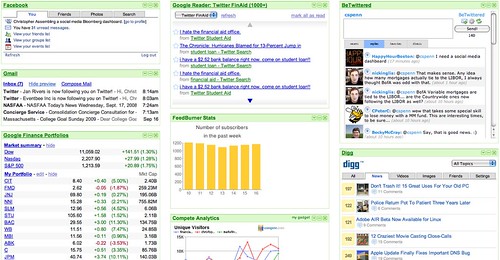Who is a social media expert?
During our drive to Podcasters Across Borders, Chris Brogan and I discussed an awful lot of things (14 hours in the car will do that) and one of those things is expertise. From my perspective, expertise follows a very distinct, well defined pattern that is measurable and obvious. If you’re marketing yourself as an expert, or you’re a business or marketer looking to hire an expert, perhaps this framework will help.
In the martial arts, there are complementary ideas of apprentice, practitioner, and master practitioner, as well as form, variation, and freedom. Even George Lucas copies this to a degree with the Padawan, Jedi Knight, and Jedi Master.
Apprentice / Beginner / Padawan
 At the beginning of any journey, we begin with form. Adherence to form is essential to learn how to use the tools, techniques, and basics of whatever it is we’re studying, whether it’s martial arts, social media, plumbing, etc. We learn form from our teachers, who are the absolute authorities in our journey. Deviation from form is discouraged because it can lead to distraction, ultimately causing you to learn less effectively. This is the stage when the apprentice learns how to hammer nails, stoke fires, roll dough, write blog posts, etc., all under the care of a master instructor who guides the apprentice through early hazards.
At the beginning of any journey, we begin with form. Adherence to form is essential to learn how to use the tools, techniques, and basics of whatever it is we’re studying, whether it’s martial arts, social media, plumbing, etc. We learn form from our teachers, who are the absolute authorities in our journey. Deviation from form is discouraged because it can lead to distraction, ultimately causing you to learn less effectively. This is the stage when the apprentice learns how to hammer nails, stoke fires, roll dough, write blog posts, etc., all under the care of a master instructor who guides the apprentice through early hazards.
Journeyman / Practitioner / Jedi Knight
In the middle of a journey, we practice variation. We now know the basics of our tools and have achieved competence with them. We can build a basic house, we can forge a sword, we can submit a story to Digg and get it to be relatively popular. At this point in our journey, we start examining variations on form to discover principle. A house doesn’t always have to be four square walls and a roof to provide effective shelter. A sword strike doesn’t always have to be on a cardinal angle. A tool like Twitter doesn’t just have to be used for presence and conversation.
Our teachers change as well, from absolute authorities to puzzlers and riddlers. They set up conditions for us to begin making our own discoveries, rather than just hand us knowledge on a plate for us to faithfully consume. Our teachers and masters inspire us to find the resources in ourselves, to experiment, accepting that we’ll screw up and break things from time to time. A sword blade will crack in the forge, a video will render wrong, a cake will fall – all of these are normal as we vary from form.
This is the most dangerous part of the journey, the point at which we can fall prey to our own Dark Side of the Force, in believing that we’re better than we actually are. Our teachers will also set us up for minor failures to remind us that we still have limits, that variation too far from the form has consequences. We’ve all seen that person who declares themselves an expert at this point, too early in their journey.
Master / Expert / Jedi Master
As we reach legitimate mastery, we leave form behind. The principles themselves remain timeless, but we no longer need variation to discover them, as we know them by heart, by practice, by long experience. A master carpenter can build a house just by eye, discarding the need for rulers and blueprints. A master baker doesn’t even bother to measure, yet the bread always turns out perfectly. A social media expert generates impressive real world results – money raised, sales made, lives saved – using whatever tools are appropriate, free of dogmatic handcuffs that say a blog must only be used in this fashion, or Twitter can only be used in that way. If the tool doesn’t exist, the expert simply crafts it themselves.
Our teachers reveal a wonderful and horrifying truth at this point in our journey, that they are fellow explorers along the path. There’s even a certification in Japanese martial arts, called menkyo kaiden, which isn’t just a way of saying that you’re great at something, but that your teacher has run out of things to teach you. You’ve learned as much as they know, and now you and your teacher are fellow explorers, making discoveries and sharing them together. You’re fellow explorers along the path, and while your teacher will always have an honored place in your life, they’re no longer responsible for your development and care. You stand on your own two feet.
Here’s the thing about true mastery, true expertise. It takes years upon years to get there, more years by many than social media has even existed. Podcasting has been around for 4 years or so. Blogging has been around for 10 years or so. Other disciplines like carpentry, martial arts, etc. have been around for millennia. For someone to appoint themselves an expert, a master in a discipline less than a decade old is puffery, plain and simple. There are certainly plenty of people who are very talented at what they do. There are also a lot of people who are peddling snake oil, promoting their latest goods with impressive sales pitches and not much to back them up.
Are there experts, masters in social media? I’d have to say no, not right now. There are leaders, pioneers, explorers, folks who are at the front of the trail, clearing the way and stumbling onto all the hazards. Eventually, if they stay the course, those people will become masters in their own right, but right now we’re all still learning variation, still discovering the principles of social media as the platform evolves.
You can always tell who is a pioneer. They’re the ones with the arrows in them.
How do you tell the difference between a legitimate leader and someone who’s just trying to make some money off of you? Look, as we have for centuries, at the results they produce. If you’re thinking about hiring someone to help you out with social media, see what other results they’ve produced. Have they run campaigns with real world results? Have they made impressive sales, saved lives, changed lives, made a difference?
Where’s Yoda when you need him?
In the next blog post, I’ll talk about another peculiarity of social media – what to do if you have no master teacher to help you.
Did you enjoy this blog post? If so, please subscribe right now!



Get this and other great articles from the source at www.ChristopherSPenn.com






 At the beginning of any journey, we begin with form. Adherence to form is essential to learn how to use the tools, techniques, and basics of whatever it is we’re studying, whether it’s martial arts, social media, plumbing, etc. We learn form from our teachers, who are the absolute authorities in our journey. Deviation from form is discouraged because it can lead to distraction, ultimately causing you to learn less effectively. This is the stage when the apprentice learns how to hammer nails, stoke fires, roll dough, write blog posts, etc., all under the care of a master instructor who guides the apprentice through early hazards.
At the beginning of any journey, we begin with form. Adherence to form is essential to learn how to use the tools, techniques, and basics of whatever it is we’re studying, whether it’s martial arts, social media, plumbing, etc. We learn form from our teachers, who are the absolute authorities in our journey. Deviation from form is discouraged because it can lead to distraction, ultimately causing you to learn less effectively. This is the stage when the apprentice learns how to hammer nails, stoke fires, roll dough, write blog posts, etc., all under the care of a master instructor who guides the apprentice through early hazards.



